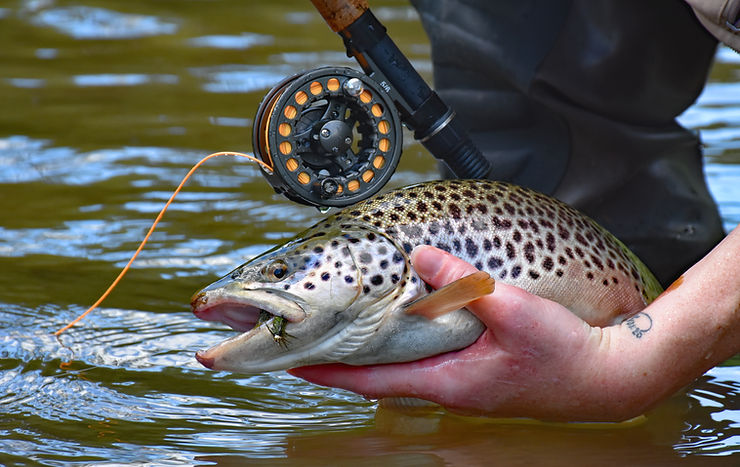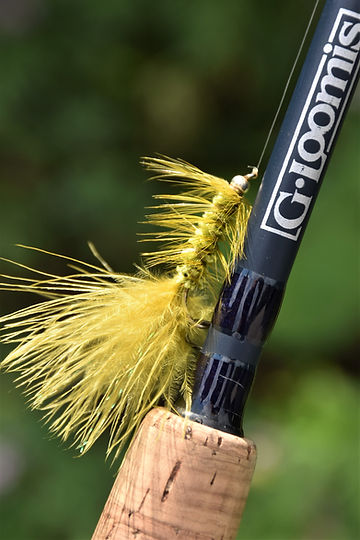The Amazing Woolly Bugger

In the world of fly fishing, the Woolly Bugger is a relatively new concoction, although its roots are centuries old. Created in 1967 by Russell Blessing, the Woolly Bugger draws from the palmer tradition of fly tying first written about as early as the 1600s with the Palmer-Worm. Wrapping the hackle around the shank was meant to imitate the segmentation of a caterpillar, but it can represent other aquatic life as well.
The Palmer-Worm originated in England, and by the time it made it to the U.S. in the early 1900s, it got a makeover (addition of a tag-like tail and weight to help it sink) and became known as the Woolly Worm. Blessing, of course, made other changes (chenille body, marabou tail) and the Woolly Bugger was born.
The fly didn’t really gain attention until 1984 when fellow Pennsylvanian Barry Beck wrote an article about it for a national fly fishing magazine. The fly was originally intended to catch smallmouth bass, and the first pattern had an olive chenille body, black hackle, and black marabou tail. Today, Woolly Buggers can be found in every color scheme imaginable, with and without bead heads, cone-shaped heads, krystal flash, flashabou, rubber legs, twister tails, and a hundred other variations. No matter the style or materials used, though, they all catch fish.
I’d wager that almost anyone, regardless of skill level, can catch a fish on a Woolly Bugger. Several years ago, I took a friend to the local Delayed Harvest for some early fall trout fishing. He’d never used a fly rod before and wanted to try it out.
That particular Delayed Harvest receives a fall stocking of trout, and I could see several of them gathered near the tail end of the pool. I demonstrated the simplest, easiest way to fish a Woolly Bugger. I stripped some line off the reel and made a roll cast straight out into the current. As the fly drifted, it swung directly downstream from our position and ended up right in front of a trout’s nose. I gave it two little twitches…fish on!
I released the fish and then handed the rod to my friend. He made a roll cast that ended up only a few feet out in front of us. Instead of making another attempt, though, he let the current drag line downstream until the fly ended up once again in front of the fish. He let the fly hang in the current for a minute before I told him to give it a couple twitches. Another fish on!

There’s no wrong way to fish a Woolly Bugger. In streams, it can be dead drifted, stripped up through the current, across current, or even down through the current if you can strip the line fast enough. In ponds and lakes, I like to cast the Woolly Bugger out, let it sink almost to the bottom, and then strip it in a few inches at a time.
One of the only mistakes I’ve seen fishermen make when using a Woolly Bugger for trout is that they use one that is too big. Fishing a fly that’s too big often results in a lot of misses or refusals. Trout will just nip at the marabou tail without fully committing to the strike, especially if the fish are more sluggish such as in extremely cold water. Scaling down fly size usually results in more hookups. I prefer sizes 8 and 10 for trout, and if I’m still missing a few trout, I’ll tie on a size 12.
One of my favorite variations of a Woolly Bugger is a Baby Bugger. I tie it on a size 10 or 12 nymph hook, with a much smaller marabou tail, a dubbed body instead of the usual chenille, and a couple wraps of hackle near the eye of the hook. I’ve had lots of success using the Baby Bugger on steelhead in the fall as well as for finicky trout that are shy of larger-profile flies.
Regardless of size or type of Woolly Bugger I use, I seldom use one that is weighted. I believe that adding weight to the shank of the hook prior to tying inhibits the action of the fly. The marabou and hackle don’t have the same life to them. If I need to get the fly deeper in the water column, I use a small split shot on the leader, about a foot and a half or so above the fly.
The color or variation of Woolly Bugger I use depends on water levels and clarity. During high water conditions, I prefer a fly with a little flash, such as a beadhead or one tied with a few strands of flashabou or tinsel in the marabou tail. During low water conditions, I like flies with no bead or added flash. I carry a wide variety of colors in my fly box – olive, olive/black, black, chartreuse, brown, white, and purple – and have caught fish on all of them and during all types of conditions, which proves that it’s not necessarily the color that makes the Woolly Bugger so effective, it’s the bugger itself.
Did You Enjoy Reading About The Woolly Bugger?
Stay up to date with the Dark Skies Fly Fishing monthly newsletter for free and receive the latest in fly fishing news, tricks, tips, and techniques, stream reports, as well as updates on new flies added to the Online Store and exclusive discounts!
Sign Up Now

When I was in my mid teens, I started to fly fish. From scrap metal, wood and screws made my first fly tying vise. A family friend showed how to tie a wooly worm fly. He said that if I kept one of these handy I would always get a fish. I have gray hair now and a suitcase of life experiences and lessons. The advise about the fly has held true to this day.